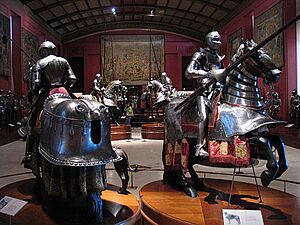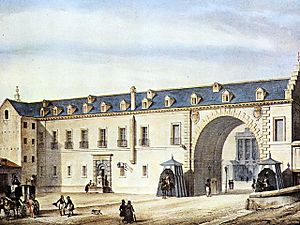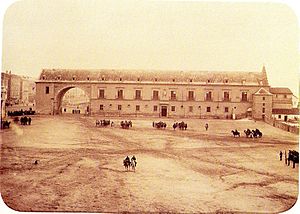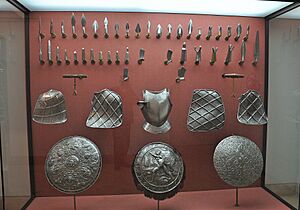Royal Armoury of Madrid facts for kids
The Royal Armoury of Madrid (or Real Armería de Madrid) is a special museum in Spain. It holds a huge collection of weapons and armor that belonged to the Kings of Spain. You can also see military weapons, fancy armor, and even art like tapestries and paintings. Some of the most amazing items are the armor and tools used by famous rulers like Charles V, Holy Roman Emperor and Philip II. Many people think it's one of the best armories in the world, right up there with the Imperial Armory in Vienna.
The idea to keep this collection extra special started after Charles V passed away on September 21, 1558.
Contents
Where the Armoury Has Been
The armor of Charles V first arrived in Spain from Brussels in September 1556. It came by ship to Laredo and then traveled to Valladolid. After he died, his weapons were spread out. Some were in Valladolid, some at the Monastery of Yuste, and maybe some at the Alcázar of Madrid.
The Old Armoury Building
The building known as the "Old Royal Armoury of Philip II" was chosen around 1553. It was meant to be new stables for the Alcázar. King Philip II himself probably designed it. You can even see a sketch he made in the Archivo General de Simancas.
This old armoury was part of the Royal Stables next to the Alcázar. It was built by Gaspar de Vega between 1556 and 1564 for King Philip II. Once it was finished, the king ordered the Armoury to be moved into the stable wing facing the Alcázar.
The new space was a long, rectangular hall, about 63 meters long and 10 meters wide. It had a ground floor and a main floor. The building had a stone ledge at the top, with a slate roof and stepped gables. The ground floor had three sections, but the upper floor, where the Armoury was, was one big open space. The inside of the hall was finished in 1565. It was painted white and decorated with many azulejo tiles from Talavera de la Reina pottery.
A special feature was the "Arch of the Armoury." This arch connected the Alcázar to the outside. It was built during the time of Charles II.
The Current Armoury Location
In 1884, a fire partly destroyed the building Philip II had built. King Alfonso XII ordered a new building to be constructed, no matter the cost. Sadly, Alfonso died before it was finished. Queen Maria Cristina made sure the work was completed. The main floor of the new building was designed as a large room. It was decorated with tapestries, weapons, and outfits, holding the entire collection. The new Armoury opened in 1893.
Today, the Royal Armoury of Madrid is on the ground floor of the Royal Palace of Madrid. It's still considered one of the best in the world, along with the Imperial Armoury in Vienna. It has pieces from as far back as the 15th century. The collection is famous for the tournament armor made for Charles V and Philip II. These were crafted by the best armor makers from Milan and Augsburg. One amazing piece is the full armor and weapons Charles V used in the Battle of Mühlberg. This armor was even shown in his famous horseback portrait by Titian, which is now in the Museo del Prado. The Armoury has some of the most important armor pieces in Europe and the world. Many were signed by Filippo Negroli, a very famous armor designer.
What You Can See in the Collections
In the old building, weapons were kept in large wooden "drawers," which were like big closets. The weapons were carefully arranged. The most important weapons were inside these drawers. Firearms, bows, and some smaller knives were placed above the windows. Longer pole weapons were at the ends of the room and on the drawers. At the western end, there were two small cannons and four sleds with their cannonballs.
The way items were organized inside the drawers was more detailed. First, weapons were grouped by their owners. Those belonging to Charles V, Holy Roman Emperor were mostly in the first eight drawers on the south side. Weapons of Philip II were stored next to his father's on the north wall. Second, some drawers held complete sets of armor, including helmets, horse coverings, and clothing for Charles V and Philip II. Third, items were grouped by type. For example, one drawer might hold only knives, another chain mail, or other items with similar features, like weapons decorated with damascene patterns. Other drawers held weapons important to the royal family, such as trophies from the battles of Mülhberg and Pavia. There were also weapons of legendary figures or those with special meaning, like the ceremonial sword of the Catholic Monarchs, a rapier sent by Pope Clement VII to Charles V, armor sent to Philip II by the shogun Toyotomi Hideyoshi, and swords said to belong to El Cid, el Gran Capitán, Roland, and Boabdil.
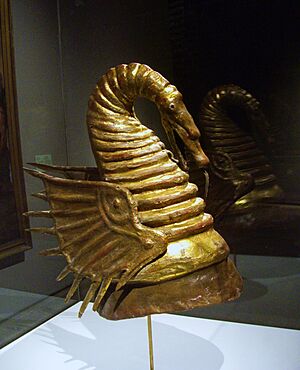
The main part of the current collection comes from the armor Philip II kept when he made Madrid the capital. This includes his own armor, but especially that of his father, Charles V. Charles V had also kept weapons from his father, Philip I of Castile, and his grandparents, Ferdinand II of Aragon and Maximilian I, Holy Holy Roman Emperor. The armor of Charles V, Holy Roman Emperor and Philip II are the most important items in the collection. Other important items were added over time, though not always regularly, from the 16th to the 19th century. These include:
- Medieval weapons from the Treasury of the Alcázar of Segovia.
- Firearms of Charles V and Philip II.
- Children's armor belonging to the Princes and Infantes of Spain.
- Military trophies.
- Gifts from other rulers and families, such as the Duke of Mantua to Charles V, the shogun Toyotomi Hideyoshi to Philip II, Charles Emmanuel I, Duke of Savoy and James I of England to Philip III, Infanta Isabel Clara Eugenia and Cardinal-Infante Ferdinand of Austria to Philip IV, and the Sultan of Turkey to Charles III.
- Firearms made in Madrid for royal hunting trips, which were very famous across Europe.
The collection also has important items from the medieval period and the start of the Renaissance. Some were part of Charles V's collection, inherited from his family. Another group came from the Royal Treasury of the Alcazar of Segovia, moved to Madrid by Philip II. Other pieces were bought, donated, or transferred between the reigns of Ferdinand VII and Alfonso XII. You can see symbols of the kingdoms of Castile, León, and Aragon on items like the spurs and cloak of Ferdinand III of Castile, which came from his burial site in the Cathedral of Seville. There's also the Drac Alat crest, believed to belong to Martin of Aragon. The royal sword of the Catholic Monarchs is also here. It was used in Spanish court ceremonies until the 18th century.
Weapons from the time of the Catholic Monarchs and the Late Middle Ages are also on display. These include war weapons from the Granada War, showing defensive pieces from Spanish, Italian, and German workshops. There are also two of the oldest portable firearms known in Spain. These early guns still show some features of the bows and arrows they would eventually replace. Special helmets and armor pieces from a unique Spanish workshop, possibly from Aragon, are also notable. The Nasrid sultanate of Granada is represented by a small but important collection of their weapons. This includes a type of spear called a genet from the collection of Cardinal-Infante Ferdinand of Austria, a leather shield from Charles V's armoury, and a dagger with a belt, pouch, and a case for a Quran. The latter items were captured from Muhammad XII (Boabdil) at the Battle of Lucena. They were later given to Alfonso XIII.
The collection also has weapons linked to important people and events from the time of the Catholic Monarchs. These include the sword of Gonzalo Fernández de Córdoba (known as el Gran Capitán) and weapons of Maximilian I, Holy Roman Emperor. The imperial items, like a horse's headpiece, a chest plate, and two horse armors, show his power and family history with their decorations and symbols. These weapons came from Charles V's collection, which also held weapons from his father, Philip I of Castile. Philip I's armor shows the marriage alliances between the Catholic Monarchs and Maximilian. Philip I's armoury is now split between the Hofjagd und Rüstkammer in Vienna and the Royal Armoury of Madrid. The Madrid collection mainly has weapons he used after his marriage to Joanna of Castile. These include a two-handed sword with his personal motto, and helmets and horse headpieces from Flemish, German, and Italian workshops. Among these are two helmets by the Milan workshop of Filippo Negroli and three armors that are rare examples of Flemish and Spanish work from that time.
The Armouries of Charles V and Philip II
The armories of Charles V, Holy Roman Emperor and Philip II are the most important part of the collection, especially Charles V's. Philip II's weapons are closely linked to his father's. Many of Philip II's armors were made while Charles V was still alive, sometimes at the same time as the Emperor's own armor. All the armors of Charles V and Philip II were made between 1519 and 1560, during the Renaissance. This was a golden age for armor making.
This collection isn't just about war weapons. It's mostly a collection of fancy, luxury weapons. They were used to show power at royal events like fairs, tournaments, military parades, and jousting. Most of Charles V's and Philip II's armors were made using a special "fitting armor" idea invented by Maximilian I, Holy Roman Emperor. This meant a basic armor set came with extra pieces or reinforcements. All parts were decorated the same way. By swapping different pieces, the armor could be changed for various uses: fighting on foot, jousting, war, or parades. The Spanish Royal Collection still has many of these extra pieces and a lot of horse armors that go with them.
These types of weapons are valued for their clever design, technical skill, and beautiful decoration. The decorations often had deep meanings, from knightly themes to ideas from humanism. They might show allegories, religious symbols, family crests, or designs inspired by Roman times. The decorations were made using techniques like etching, light embossing, gilding (adding gold), silvering, bluing, and damascening (inlaying gold and silver). Because of this, luxury weapons could only be made and decorated in a few highly skilled workshops across Europe. The most important ones were in Germany and northern Italy. For Charles V, famous workshops included Kolman and Desiderius Helmschmid from Augsburg, and Filippo Negroli and his brothers from Milan. For Philip II, Franz and Wolfgang Grosschedel from Landshut, Desiderius Helmschmid, and Anton Peffenhauser from Augsburg were important. Both Charles V and Philip II also owned weapons from other top workshops, like Mattheus Frawenbrys, Caremolo Mondrone, or Bartolomeo Campi. These might have been special orders or gifts from people connected to the Spanish Court.
See also
 In Spanish: Real Armería de Madrid para niños
In Spanish: Real Armería de Madrid para niños


